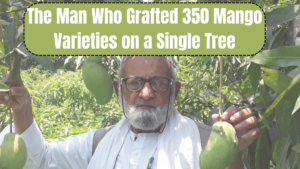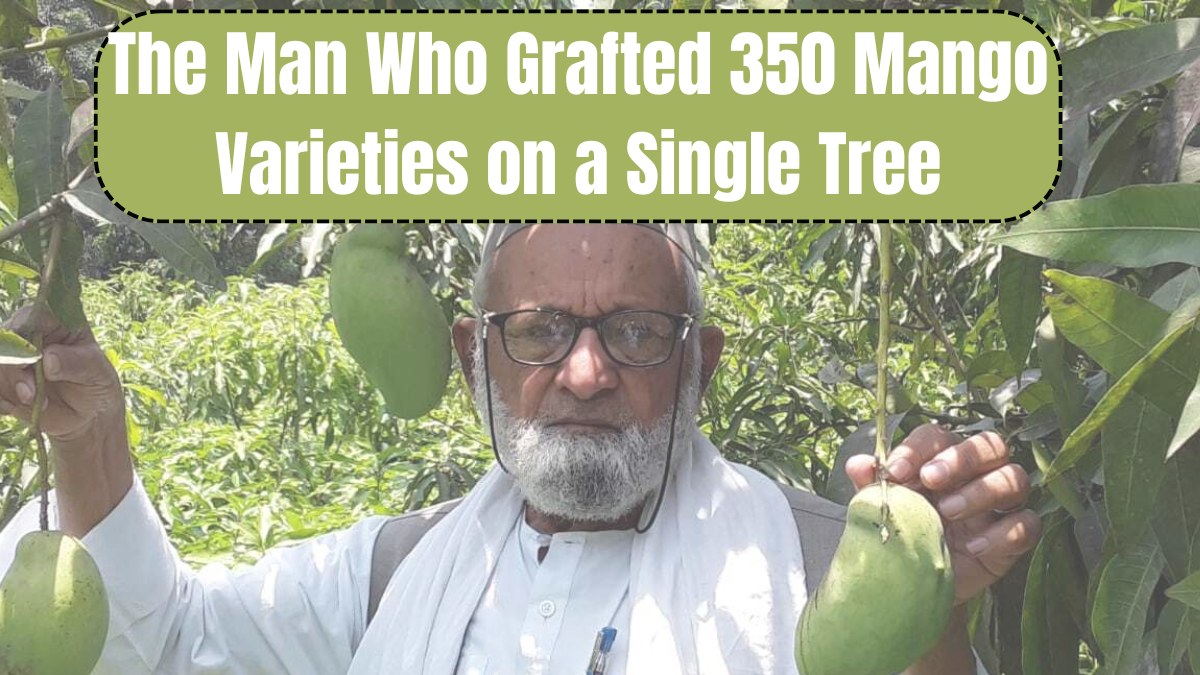Kalimullah Khan’s journey from a school dropout to the country’s most celebrated mango cultivator is not just an agricultural feat but a story of deep passion, patience, and legacy. Known as the ‘Mango Man of India,’ the 84-year-old horticulturist from Malihabad, Uttar Pradesh, has grown over 350 mango varieties on a single tree, a marvel that stands as a testament to innovation and tradition.
Despite failing in school and leaving formal education after Class 7, Kalimullah’s unwavering love for mangoes drove him to become a self-taught expert in grafting, a centuries-old horticultural technique.

From Soil to Spotlight: Kalimullah Khan’s Humble Beginnings
Kalimullah’s journey began in the 1950s after he took over his family’s orchard. His first experiment aimed to grow seven mango varieties on one tree, but a devastating flood wiped out his early efforts. Undeterred, he studied the behavior of soil, roots, and branches, eventually mastering the grafting technique, which allowed him to successfully grow hundreds of mango types on a single rootstock.
The legendary tree — now over 125 years old — belongs to his grandfather and is the centerpiece of a 22-acre orchard, now managed by Kalimullah’s son, Nazimullah Khan.
The Art and Science of Mango Grafting
Grafting involves attaching branches from different mango varieties to a single tree. This allows each grafted branch to retain its original fruit characteristics while sharing a common root system. Kalimullah perfected this art, creating a 9-meter tall tree bearing mangoes of various colors, flavors, and textures.
Each graft requires:
-
A healthy rootstock with a robust root system
-
Careful selection of compatible mango varieties
-
Years of nurturing and precision for proper fusion
-
Pest control, weather monitoring, and maintenance to ensure balance
A Legacy Passed from Father to Son
Kalimullah’s son, Nazimullah Khan, joined him nearly 30 years ago. Initially stepping in due to his father’s failing health, he soon developed a love for the orchard and took full charge after leaving school post-Class 12.
Together, the father-son duo created unique mango hybrids like ‘Dushehri Kalim’ and ‘Sachin Tendulkar’, with names inspired by public figures including Aishwarya Rai, Narendra Modi, and Amitabh Bachchan.
India’s Sweetest Tree: Varieties and Recognition
The tree includes popular mangoes like:
-
Alphonso – rich, sweet, velvety
-
Kesar – fragrant with tangy notes
-
Langra – green-skinned with fibreless pulp
-
Chaunsa – thick pulp and extraordinary aroma
-
Dasheri – juicy and tangy-sweet
Hybrid and custom-developed mangoes carry unique flavor combinations, textures, and stories behind each graft. The names, size, and appearance vary with rainfall and climate, making orchard management a year-round challenge.
International Fame and Scientific Interest
Kalimullah’s orchard has not only attracted national media attention but also international visitors from Iran and Dubai, who visit to learn his grafting techniques. His work is documented in the Limca Book of Records, and he is a Padma Shri awardee, one of India’s highest civilian honors.
He believes that with effort, mangoes can even grow in deserts, and wants to be buried next to the trees he lovingly raised.
FAQs
Who is Kalimullah Khan?
Kalimullah Khan is an 84-year-old horticulturist from Malihabad, Uttar Pradesh, known for grafting over 350 varieties of mangoes onto a single tree.
What is grafting, and how is it used in mango trees?
Grafting is a technique where branches from different mango varieties are joined onto one rootstock. Each branch retains its original fruit characteristics, allowing multiple mango varieties to grow on a single tree.
How many mango varieties are on Kalimullah Khan’s tree?
Kalimullah Khan’s most famous tree carries over 350 different mango varieties, each distinct in taste, texture, size, and color.
Are these mangoes sold commercially?
While many varieties grown in the orchard are sold, the mangoes on the main tree are mostly preserved for heritage, research, and demonstration purposes.
Who maintains the orchard now?
Kalimullah’s son, Nazimullah Khan, has taken over the orchard’s daily operations and continues the legacy through grafting and innovation.
Has Kalimullah received any awards for his work?
Yes, he has been honored with the Padma Shri, and his achievements are listed in the Limca Book of Records.
Where is the orchard located?
The orchard is located in Malihabad, a small town near Lucknow, Uttar Pradesh — known as India’s “Mango Belt.”
Click here to know more.
Aanchal is a passionate writer with a keen interest in storytelling, content creation, and creative expression. She enjoys exploring diverse topics and crafting engaging narratives that captivate readers.
